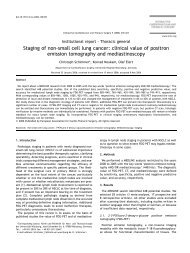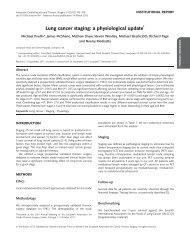Bilocular pericardial cyst in an aberrant location - Interactive ...
Bilocular pericardial cyst in an aberrant location - Interactive ...
Bilocular pericardial cyst in an aberrant location - Interactive ...
You also want an ePaper? Increase the reach of your titles
YUMPU automatically turns print PDFs into web optimized ePapers that Google loves.
doi:10.1510/icvts.2008.180729<br />
Abstract<br />
2009 Published by Europe<strong>an</strong> Association for Cardio-Thoracic Surgery<br />
ARTICLE IN PRESS<br />
<strong>Interactive</strong> CardioVascular <strong>an</strong>d Thoracic Surgery 8 (2009) 160–161<br />
Case report - Thoracic general<br />
<strong>Bilocular</strong> <strong>pericardial</strong> <strong>cyst</strong> <strong>in</strong> <strong>an</strong> aberr<strong>an</strong>t <strong>location</strong><br />
a, a a b<br />
Federico Raveglia *, Aless<strong>an</strong>dro Baisi , Angelo Maria Calati , Larry R. Kaiser<br />
aDivision<br />
of Thoracic Surgery, Università degli Studi di Mil<strong>an</strong>o, Azienda Ospedaliera S<strong>an</strong> Paolo, Mil<strong>an</strong>o, Italy<br />
bDivision<br />
of Thoracic Surgery, University of Pennsylv<strong>an</strong>ia School of Medic<strong>in</strong>e, Philadelphia, PA, USA<br />
Received 31 March 2008; received <strong>in</strong> revised form 26 May 2008; accepted 21 July 2008<br />
www.icvts.org<br />
Pericardial <strong>cyst</strong>s classically are found <strong>in</strong> the right or left cardiophrenic <strong>an</strong>gle <strong>an</strong>d rarely are located outside of this <strong>location</strong>. An 82-yearold<br />
m<strong>an</strong> presented with <strong>an</strong> asymptomatic <strong>cyst</strong>ic mass on chest CT-sc<strong>an</strong> located <strong>in</strong> the upper right mediast<strong>in</strong>um <strong>an</strong>d measur<strong>in</strong>g 7=6=4 cm.<br />
A follow-up chest CT-sc<strong>an</strong> 12 months later showed that the <strong>cyst</strong> had <strong>in</strong>creased <strong>in</strong> size to where it now measured 10=9=8 cm <strong>an</strong>d was<br />
noted to be dislocat<strong>in</strong>g <strong>an</strong>d compress<strong>in</strong>g the superior vena cava. The patient underwent surgical excision because of the uncerta<strong>in</strong> diagnosis<br />
<strong>an</strong>d the compression of contiguous org<strong>an</strong>s. Two <strong>cyst</strong>ic masses were able to be completely excised <strong>in</strong>tact. A def<strong>in</strong>itive diagnosis of double<br />
<strong>pericardial</strong> <strong>cyst</strong> was histopathologically confirmed. Radiological f<strong>in</strong>d<strong>in</strong>gs of a <strong>pericardial</strong> <strong>cyst</strong> <strong>in</strong> the upper mediast<strong>in</strong>um are extremely rare.<br />
In particular there have been no reports of bilocular or double <strong>pericardial</strong> <strong>cyst</strong>s.<br />
2009 Published by Europe<strong>an</strong> Association for Cardio-Thoracic Surgery. All rights reserved.<br />
Keywords: Pericardial <strong>cyst</strong>; Mediast<strong>in</strong>um<br />
1. Cl<strong>in</strong>ical summary<br />
An 82-year-old m<strong>an</strong> with a history of systemic vasculopathy<br />
presented with <strong>an</strong> asymptomatic <strong>cyst</strong>ic mass on chest<br />
CT-sc<strong>an</strong> measur<strong>in</strong>g 7=6=4 cm. CT-sc<strong>an</strong> had been performed<br />
on the base of <strong>an</strong> X-ray previously done dur<strong>in</strong>g<br />
preoperative evaluation for <strong>in</strong>gu<strong>in</strong>al hernia repair. A followup<br />
chest CT-sc<strong>an</strong> 12 months later showed that the <strong>cyst</strong> had<br />
<strong>in</strong>creased <strong>in</strong> size to where it now measured 10=9=8 cm<br />
<strong>an</strong>d was noted to be dislocat<strong>in</strong>g <strong>an</strong>d compress<strong>in</strong>g the<br />
superior vena cava <strong>an</strong>d the azygos ve<strong>in</strong> (Fig. 1). A tr<strong>an</strong>sesophageal<br />
echocardiogram confirmed a large fluid-filled<br />
mediast<strong>in</strong>al mass. It was recommended to the patient that<br />
he undergo surgical excision because of the uncerta<strong>in</strong><br />
diagnosis <strong>an</strong>d the compression of contiguous org<strong>an</strong>s.<br />
The surgical procedure was begun by <strong>in</strong>troduc<strong>in</strong>g two<br />
trocars with the <strong>in</strong>tent to perform the procedure via a<br />
thoracoscopic technique. Dense pleural adhesions were<br />
encountered <strong>an</strong>d a 6-cm muscle spar<strong>in</strong>g right thoracotomy<br />
<strong>in</strong>cision was performed. Upon enter<strong>in</strong>g the chest, a th<strong>in</strong>walled<br />
<strong>cyst</strong>ic mass was noted <strong>in</strong> the paratracheal <strong>location</strong><br />
compress<strong>in</strong>g both the superior vena cava <strong>an</strong>d the azygos<br />
ve<strong>in</strong> (Fig. 2). The <strong>cyst</strong>ic mass was able to be completely<br />
excised <strong>in</strong>tact. A second smaller <strong>cyst</strong>, not seen on the CTsc<strong>an</strong>,<br />
was found posterior to the larger <strong>cyst</strong>ic mass <strong>in</strong> the<br />
medial aspect of the mediast<strong>in</strong>um, adjacent to the aortic<br />
arch. This smaller <strong>cyst</strong>ic mass was also excised. Histologic<br />
exam<strong>in</strong>ation revealed a mesothelial-l<strong>in</strong>ed <strong>cyst</strong>ic lesion <strong>an</strong>d<br />
the diagnosis of double <strong>pericardial</strong> <strong>cyst</strong> was confirmed. The<br />
*Correspond<strong>in</strong>g author. Piazza L. da V<strong>in</strong>ci 7, 20133, Mil<strong>an</strong>, Italy. Tel.: q39-<br />
3381336071; fax: q39-022666185.<br />
E-mail address: ravegliafederico@tiscali.it (F. Raveglia).<br />
patient was discharged from the hospital on the fourth<br />
postoperative day.<br />
2. Discussion<br />
Pericardial <strong>cyst</strong>s classically are found <strong>in</strong> the right or left<br />
cardiophrenic <strong>an</strong>gle <strong>an</strong>d rarely are located outside of this<br />
<strong>location</strong> w1x. In review<strong>in</strong>g the literature from 1929 to 1985,<br />
Stoller et al. noted only 34 cases of <strong>pericardial</strong> <strong>cyst</strong>s <strong>in</strong><br />
aberr<strong>an</strong>t <strong>location</strong>s w2x. From 1985 to the present only<br />
occasional cases of atypically located <strong>pericardial</strong> <strong>cyst</strong>s have<br />
been reported. However, to our knowledge, there have<br />
been no reports of bilocular or double <strong>pericardial</strong> <strong>cyst</strong>s. In<br />
our patient, the diagnosis of bilocular <strong>cyst</strong> was made only<br />
Fig. 1. CT-sc<strong>an</strong>. Gi<strong>an</strong>t <strong>cyst</strong> <strong>in</strong> upper right mediast<strong>in</strong>um.
ARTICLE IN PRESS<br />
F. Raveglia et al. / <strong>Interactive</strong> CardioVascular <strong>an</strong>d Thoracic Surgery 8 (2009) 160–161<br />
Fig. 2. Open view of the <strong>cyst</strong> wall dislocat<strong>in</strong>g the azygos ve<strong>in</strong>.<br />
at the time of operation because the membr<strong>an</strong>e between<br />
the <strong>cyst</strong>ic lesions was th<strong>in</strong> <strong>an</strong>d not identifiable on the CTsc<strong>an</strong><br />
or on the tr<strong>an</strong>sesophageal echocardiogram.<br />
3. Conclusion<br />
Surgical resection is widely accepted as the treatment of<br />
choice when a patient has symptoms related to a mediast<strong>in</strong>al<br />
mass or the diagnosis is uncerta<strong>in</strong> w2x. We agree with<br />
Mouroux et al.’s contention that asymptomatic <strong>cyst</strong>s should<br />
be considered for resection when the lesion is large <strong>an</strong>d<br />
there is compression of adjacent structures, <strong>an</strong>d particularly<br />
when the CT-sc<strong>an</strong> demonstrates progressive enlargement.<br />
If feasible, it is our op<strong>in</strong>ion that these lesions should<br />
be resected us<strong>in</strong>g m<strong>in</strong>imally <strong>in</strong>vasive thoracoscopic techniques<br />
w3, 4x.<br />
References<br />
w1x Davis RD Jr, Oldham HN Jr, Sabiston DC. Primary <strong>cyst</strong>s <strong>an</strong>d neoplasms<br />
of the mediast<strong>in</strong>um: recent ch<strong>an</strong>ges <strong>in</strong> cl<strong>in</strong>ical presentation, methods<br />
of diagnosis, m<strong>an</strong>agement <strong>an</strong>d results. Ann Thorac Surg 1987;44:229–<br />
237.<br />
w2x Stoller JK, Shaw C, Matthay RA. Enlarg<strong>in</strong>g atypically located <strong>pericardial</strong><br />
<strong>cyst</strong>. Chest 1986;89:402–406.<br />
w3x Mouroux J, Vennissac N, Leo F, Guillot F, Padov<strong>an</strong>i B, Hofm<strong>an</strong> P. Usual<br />
<strong>an</strong>d unusual <strong>location</strong>s of <strong>in</strong>trathoracic mesothelial <strong>cyst</strong>s. Is endoscopic<br />
resection always possible? Eur J Cardiothorac Surg 2003;24:684–688.<br />
w4x Umemori Y, Kot<strong>an</strong>i K, Makihara S. Video-assisted thoracoscopical surgery<br />
for <strong>pericardial</strong> <strong>cyst</strong>: report of two cases. Kyobu Geka 2001;54:1125–<br />
1127.<br />
161
















